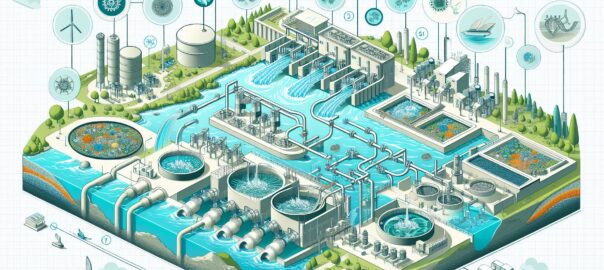In the quest for sustainable environmental stewardship, the management of wastewater stands as one of the most critical and challenging components of modern urban infrastructure. An integrated wastewater treatment system is not just a need but a necessity for the preservation of public health and the environment. This comprehensive guide delves into the features, benefits, advantages, and complexities of an integrated wastewater system, encompassing a substantial spectrum of design, technology, and operational aspects to enhance its efficiency and effectiveness.
Introduction
Wastewater treatment is an indispensable process that ensures water from household, industrial, and agricultural activities is treated before being discharged into the environment. The integration of various components within these treatment systems aims to streamline processes, optimize performance, and meet regulatory compliance, all while keeping operational costs at bay. The concept of an integrated wastewater treatment system stitches together a combination of physical, chemical, and biological processing units to tackle the pollutants and render the water safe for discharge or reuse.
The Components of an Integrated Wastewater Treatment System
1. Pretreatment
The initial stage involves removing large solids and grit that could damage equipment or hinder subsequent treatment processes.
2. Primary Treatment
Primary treatment is aimed at settling out suspended solids and organic matter. This typically includes sedimentation tanks or clarifiers that allow solids to settle by gravity.
3. Secondary Treatment
During the secondary treatment, the biological content of the sewage is substantially degraded through microbial action. Activated sludge systems, biofilters, and oxidation ponds are commonly used technologies in this phase.
4. Tertiary Treatment
Tertiary or advanced treatment is tailored to remove any remaining inorganic compounds, bacteria, viruses, and nutrients like nitrogen and phosphorus.
5. Disinfection
Before the effluent is discharged, it undergoes disinfection to eliminate harmful microorganisms. Chlorination, ultraviolet light, and ozone are common methods used.
6. Sludge Treatment
The solids collected from the primary and secondary treatment processes are treated separately. This involves stabilization, dewatering, and sometimes incineration or land application.
Benefits of Integration
Integrating the components of a wastewater treatment system results in a streamlined and efficient process, leading to several benefits:
- Reduced footprint: Integrated systems often occupy less space than traditional segregated systems.
- Cost efficiency: Combining operations can lead to cost savings in construction, energy consumption, and maintenance.
- Enhanced performance: Integration allows for the optimization of each step in the treatment, improving overall performance and ensuring compliance with discharge regulations.
- Sustainability: An integrated approach can foster closed-loop systems, facilitating water reuse and resource recovery.
Advancements in Technology and Integration
Recent developments in the field of wastewater treatment have focused on enhancing the integration of systems:
- Smart Sensors and IoT: The incorporation of smart sensors and the Internet of Things (IoT) has allowed for real-time monitoring and adaptive control of treatment processes.
- Advanced Biological Treatment: Innovations such as membrane bioreactors (MBRs) combine secondary and tertiary treatment into one step, increasing efficiency.
- Energy Recovery: Systems are now being designed to recover energy from the treatment process itself, such as capturing methane from anaerobic digesters for power generation.
Integration in Practice: Case Studies
Examining real-world applications illustrates the effectiveness of integrated wastewater treatment systems:
- Singapore’s NEWater: Singapore’s approach to water recycling involves an advanced integrated system that includes microfiltration, reverse osmosis, and UV disinfection, supplying high-quality reclaimed water for industrial and other non-potable uses.
- Orange County Groundwater Replenishment System (GWRS): In California, the GWRS is an example of cutting-edge technology meeting stringent environmental requirements through an integrated system that recharges the local groundwater basin with treated wastewater.
Challenges and Considerations
While integration offers numerous benefits, there are challenges to be tackled:
- Complexity: Integrated systems demand a higher level of expertise to design and maintain, which can limit their adoption in areas with less technical capacity.
- Initial Cost: The upfront investment for sophisticated integrated systems can be prohibitive, especially for small communities or developing nations.
- Regulatory Hurdles: Tougher regulations can increase the requirements for treatment and monitoring, potentially complicating the integration process.
Best Practices for Implementation
To ensure successful application and operation of integrated systems, certain best practices should be followed:
- Comprehensive Planning: Engage in meticulous planning and design phases to tailor the system to specific local needs and conditions.
- Stakeholder Engagement: Involve community members, local businesses, and regulatory agencies in the decision-making process.
- Continuous Training: Invest in ongoing training for operators and managers to keep up with technological advances and maintain system efficiency.
- Maintenance and Upgrades: Develop a proactive maintenance strategy and remain open to system upgrades to incorporate new technologies or expand capacity.
Conclusion
An integrated wastewater treatment system represents an interconnected web of technologies and processes working in harmony to protect public health and preserve our water resources. As urbanization increases and environmental pressures mount, these systems will play a pivotal role in fostering sustainable cities and communities. Embracing advancements in technology and integration, while addressing the inherent challenges, will ensure that we, as global citizens, contribute to the longevity and health of our planet.
Sources
- Metcalf & Eddy, Inc. (2014). Wastewater Engineering: Treatment and Resource Recovery. McGraw-Hill Education.
- Singapore Public Utilities Board (PUB). NEWater. Retrieved from https://www.pub.gov.sg/watersupply/fournationaltaps/newater
- Orange County Water District (OCWD). Groundwater Replenishment System. Retrieved from https://www.ocwd.com/gwrs
Undoubtedly, the comprehensive management of wastewater through integrated systems offers a pathway to environmental sustainability and public health protection. As technologies evolve and communities grow, the ongoing development and refinement of these systems will remain a central focus for engineers, policymakers, and environmental advocates worldwide.
